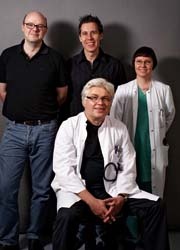Post-MI mortality
Heart rate turbulence (HRT) is confirmed risk predictor
Measuring left ventricle ejection fraction (LVEF) is the gold standard for determining the risk of cardiac death or sudden cardiac death after a myocardial infarction (MI). If LVEF is below 30%, a cardioverter-defibrillator is implanted to avoid such an event.

However,the sensitivity of this method is low: in the recently published ISAR Risk Trial less than 25% of the patients who died after an MI had shown severely reduced LVEF. ‘That means, the majority of the patients fell through the risk grid and thus were neither identified nor protected,’ Georg Schmidt, Professor of Cardiology at the First Medical Clinic and the German Heart Centre, at the Technical University, Munich, explained during our recent interview
Prof Schmidt and his colleagues looked at heart rate turbulence (HRT) as a risk predictor: ‘We wanted to find a way to stratify the 75% of patients who die although they did not show reduced LVEF. Modern cardiology knows different methods to predict risk, such as measuring electronic instability, with T-wave alternans for example. For this study, however, we focused on measuring heart rate turbulence, a method that was developed in Munich back in 1999 and identifies a dysfunction of the patient’s autonomic nervous system.’
This method analyses the heart’s response to a premature ventricular contraction (PVC). In healthy humans the response to a PVC is bi-phasic: a short acceleration is followed by a deceleration of the heart rate as the PVC causes a temporary decrease of arterial blood pressure. After 10-20 seconds the heart frequency returns to its normal rate. In risk patients, however, this response, which is initiated by the autonomic nervous system, does not occur.
In addition to HRT, cardiologists look at the deceleration capacity (DC) which indicates the direction of the response: sympathetic or parasympatric nerve. ‘For the prospective cohort study we measured both values – DC and HRT – in 2,343 patients with long-term ECG. The result: Of the 189 post-MI deaths, only 39 patients had shown an LVEF below 30%,’ Prof. Schmidt said. ‘Within this patient group, five-year mortality was at roughly 40%, among patients with a higher LVEF mortality was at 10%. The group of patients with severe autonomic failure (SAF) showed similar results to the group with medium to no dysfunction. Interestingly, the group with severely reduced LEVF and the SAF-group had only little overlap. This means, if we measure both values, that we catch a significantly larger group of patients at risk. Both with regard to cardiac death and sudden cardiac death the number of patients identified increased from 25% to 50%.’
Compared to the sole measurement of left ventricular ejection fraction, additional analysis of the autonomic nervous system, by way of measuring HRT and DC, provides a significant improvement of the diagnostic identification of patients at risk. Obviously, the ISAR risk trial study does not answer the question of whether an implantable cardioverter-defibrillator would have helped these patients. This requires further research, which is currently being designed.
01.09.2009











